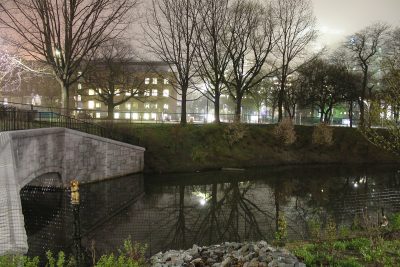
Justine Mee Liff Park opened Friday afternoon as the first part of the Muddy River Restoration Project, which is an effort to address flood control and environmental issues through restoration work, according to a fact sheet provided by the Boston Parks and Recreation Department.
The opening of the park, which is part of the Emerald Necklace park system, is the first phase of a two-phase project that aims to rehabilitate the Emerald Necklace and alleviate flooding by “dredging and removing invasive plants,” according to the fact sheet.
The project was designed by the U.S. Army Corps of Engineers, and will create new habitat areas and improve access through the park system, in addition to addressing the flooding issue, according to the fact sheet.
Ryan Woods, director of external affairs for the Parks and Recreation Department, said the first phase involved daylighting the river, which means transferring water running through underground pipes back above ground.
“There used to be pipes underneath that water would run through, but when we got heavy rains and storms it would become a flood zone and the pipes would become backed up,” Woods said. “By doing this, it becomes a natural daylight river instead of going through pipes.”
Kate Oeser, marketing and communications coordinator for the Emerald Necklace Conservancy, said the park was formerly part of an initiative by Frederick Law Olmsted to control flooding.
However, Oeser said the design stopped functioning correctly because of an increase in buildings and concrete surrounding the area, in addition to the presence of invasive phragmites, which are weeds that break down soil and cause backups in waterways.
“A lot of buildings and concrete had been built around [the Muddy River] so it needed to take in more water and more runoff because the land around it just couldn’t do it anymore,” Oeser said.
As a result of these backups, the Muddy River overflowed in 1996, which caused millions of dollars in damage to surrounding businesses and to the MBTA subway, which was closed for one month, Oeser said.
Oeser said in order to prevent such damage from occurring again, the conservancy was founded to initiate the restoration project.
Justine Mee Liff Park has replaced a Landmark Center parking lot, which is what Mee Liff, the late Parks and Recreation commissioner for the city of Boston, wanted for the restoration, Oeser said.
“Justine Mee Liff’s vision was to take that parking lot back for the park, and that’s exactly what has happened here and what the conservancy has advocated for since it’s conception,” Oeser said. “That’s why the conservancy was founded. It was on this issue of the Muddy River Restoration.”
The Emerald Necklace Conservancy considered the opening of the park a success because there were more people in attendance than anticipated, Oeser said.
“The room was overfilled with people — there were more people than there were seats,” Oeser said. “There was a lot of excitement for the ribbon cutting.”
The second phase of the Muddy River Restoration Project will involve continuing development upstream and downstream from the Phase 1 area, Oeser said.
“We’ll be continuing along the river way and … further into the Back Bay Fens area, and removing more invasive phragmites,” Oeser said.
Oeser said the specific details of the project remain unclear because it is still being planned.
“The current Phase 2 project is in the 60 percent design phase so we only know so much about what it will look like,” Oeser said.
Several Boston residents expressed support for the project.
Bobby Andrews, 25, of Brighton, said the project will enhance the feel of the Fenway area, a location he described as becoming increasingly gentrified.
“The whole Fenway area is becoming more and more gentrified, with many new luxury apartments being built,” Andrews said. “The Muddy River Restoration Project adds a nice touch to the up-and-coming neighborhood.”
Anlin Van, 22, of Allston, said she hopes that as the restoration continues, it will not endanger habitats that exist upstream and downstream from the Phase 1 area.
“I like the idea about improving ecosystems, but we should also consider the impact the restoration will have on the environment while it is still in construction,” Van said.
Alex Mok, 20, of Brighton, said his personal experience with a flood makes him especially supportive of the project.
“Flood damage has affected me personally so I think it’s a good idea,” Mok said. “There’s no reason not to support this project.”


















































































































